Accepted Scientific Name: Maihueniopsis bonnieae (D.J.Ferguson & R.Kiesling) E.F.Anderson
Cact. Succ. J. (Los Angeles) 71(6): 325. 1999 [24 Nov 1999]
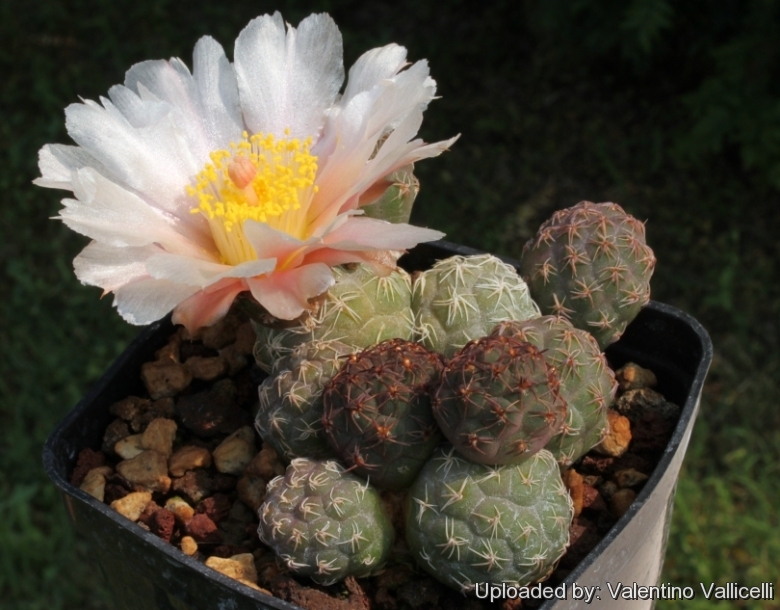
Opuntia bonnieae (Maihueniopsis bonnieae) Photo by: Valentino Vallicelli
Flower Light Pink , 4 cm in diameter
Discovered by D. J. Ferguson, S. Hogan and Bonnie Brunkow in the early 1990
Origin and Habitat: This species is endemic to Argentina, where it occurs in Catamarca at elevations of 2,500 to 3,300 m asl. The extent of occurrence is about 20 km². It has a very restricted range and certainly it has less than five locations, but the range may extend to the tops of the hills or even higher up the mountains south of the present location.
Type locality: Río Guanchín, near Loro (Lora) Huasí, Dept. Tinogasta, prov. Catamarca, Argentina ca. 2000 metres above sea level.
Habitat: It grows on high altitude in an almost lifeless rocky soil in the puna community vegetation. The climate conditions are extremely dry, with scarce rains. During the dry time, the plant bodies are almost completely retracted and hidden into the ground. The population is sacked by collectors, hence a continuing decline of mature individuals is inferred, however considering the plants are buried underground for most of the year it is difficult to estimate the population size.
Note: The indigenous word "Puna" indicate the western region up to 4500 m that extends from the Peru, going throughout Bolivia to the Argentinian North. Delimited at west by a costal chain of high volcanic picks and by the Cordillera mountainous chain to the east. The Argentinian Puna is the natural continuation of the Bolivian highland.
Synonyms:
See all synonyms of Maihueniopsis bonnieae
back
Accepted name in llifle Database:Maihueniopsis bonnieae (D.J.Ferguson & R.Kiesling) E.F.AndersonCact. Succ. J. (Los Angeles) 71(6): 325. 1999 [24 Nov 1999]Synonymy: 4
Cultivars
(1):
back
Description: Maihueniopsis bonnieaeSN|1024]]SN|1024]], best known in cultivation as Puna bonnieaeSN|1023]]SN|1023]], is a small geophytic opuntioid that looks like a small Tephrocactus geometricus, but the bloom, fruit and the seeds clearly show its autonomous nature. During the dry season they are hidden in the ground. It forms slowly small cushion up to 15 cm in diameter.
Stem: Small usually globular, obconical to slightly elongated up to 2.5 cm tall and in diameter, they are broadly attached basally and do not detach easily from the mother plants. It is possibly an adaptation to high altitudes. They are dull blue-green but turns to dirty grey as they ages.
Tubercles: low, bordered with grooves and slightly depressed in the centre in correspondence of the areole.
Areoles: Up to 30 per segment, closely set, with glochids and spines only in the upper part of the stem.
Central spines: Absent.
Radial spines: 9 to 20. Pinkish, orangish, reddish to darker brown in the young stems, they turn to a whitish grey colour with age. They are very short, flattened and radiating and slightly bent over the stem.
Roots: It has a large turnip, branched, subterranean storage root (The roots of Tephrocactus are fibrous)
Flower: Flower Light Pink or Pinkish, 3-4 cm in diameter, arising from buds with white felt. The pericarp is naked or has only few areoles with some bristle-like spines up to 3 mm long. This feature is typical for Punas (While the pericarpus of Theprocactus has numerous areoles)
Fruit: The fruit is obovoid, top shaped, about 1-1,5 cm long almost naked and free of areoles. It is thin walled, fleshy becoming dry at maturity.
Subspecies, varieties, forms and cultivars of plants belonging to the Maihueniopsis bonnieae group
 Maihueniopsis bonnieae (D.J.Ferguson & R.Kiesling) E.F.Anderson: has small globular stems up to 2.5 cm in diameter with 9-20 radial spines per areole. It has a large turnip root. Distribution: Catamarca, Argentina.
Maihueniopsis bonnieae (D.J.Ferguson & R.Kiesling) E.F.Anderson: has small globular stems up to 2.5 cm in diameter with 9-20 radial spines per areole. It has a large turnip root. Distribution: Catamarca, Argentina. Maihueniopsis bonnieae cv. Inermis: this is a lovely spineless form (without spines).
Maihueniopsis bonnieae cv. Inermis: this is a lovely spineless form (without spines).
Bibliography: Major references and further lectures
1) Edward Anderson “The Cactus family” Timber Press, Incorporated, 2001
2) David R. Hunt “Studies in the Opuntioideae (Cactaceae)” D. Hunt, 2002
3) James Cullen, Sabina G. Knees, H. Suzanne Cubey "The European Garden Flora Flowering Plants: A Manual for the Identification of Plants Cultivated in Europe, Both Out-of-Doors and Under Glass" Cambridge University Press, 11/Aug/2011
4) David R Hunt; Nigel P Taylor; Graham Charles; International Cactaceae Systematics Group. "The New Cactus Lexicon" dh books, 2006
5) Demaio, P., Kiesling, R., Trevisson, M. & Perea, M. 2013. Tephrocactus bonnieae. The IUCN Red List of Threatened Species. Version 2014.3. <www.iucnredlist.org>. Downloaded on 19 May 2015.
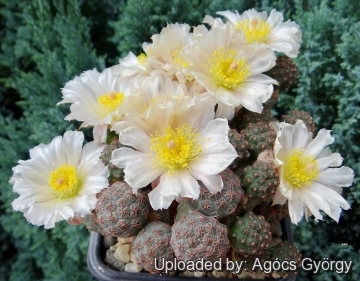 Opuntia bonnieae (Maihueniopsis bonnieae) Photo by: Agócs György
Opuntia bonnieae (Maihueniopsis bonnieae) Photo by: Agócs György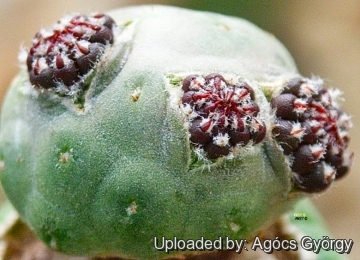 Rebutialand cactus collection Demjén, Hungary. (Maihueniopsis bonnieae) Photo by: Agócs György
Rebutialand cactus collection Demjén, Hungary. (Maihueniopsis bonnieae) Photo by: Agócs György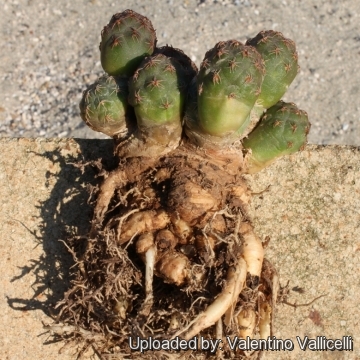 Opuntia bonnieae (Maihueniopsis bonnieae) Photo by: Valentino Vallicelli
Opuntia bonnieae (Maihueniopsis bonnieae) Photo by: Valentino Vallicelli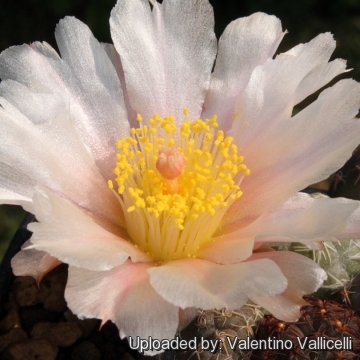 Opuntia bonnieae (Maihueniopsis bonnieae) Photo by: Valentino Vallicelli
Opuntia bonnieae (Maihueniopsis bonnieae) Photo by: Valentino Vallicelli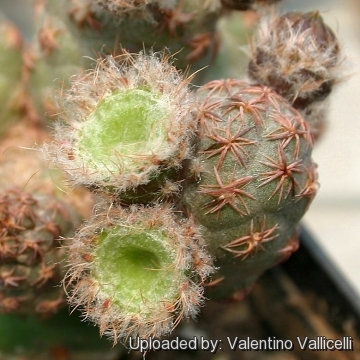 Opuntia bonnieae (Maihueniopsis bonnieae) Photo by: Valentino Vallicelli
Opuntia bonnieae (Maihueniopsis bonnieae) Photo by: Valentino Vallicelli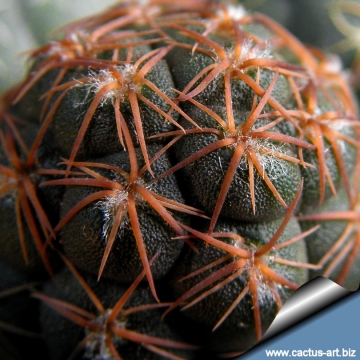 Opuntia bonnieae (Maihueniopsis bonnieae) Photo by: Cactus Art
Opuntia bonnieae (Maihueniopsis bonnieae) Photo by: Cactus Art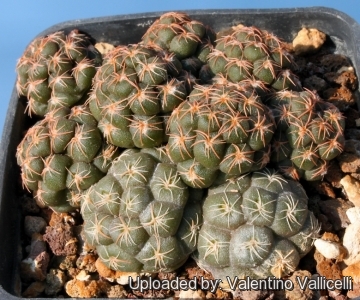 Opuntia bonnieae (Maihueniopsis bonnieae) Photo by: Valentino Vallicelli
Opuntia bonnieae (Maihueniopsis bonnieae) Photo by: Valentino Vallicelli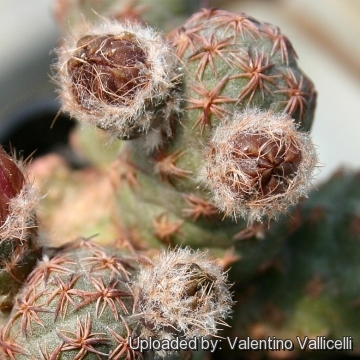 Opuntia bonnieae (Maihueniopsis bonnieae) Photo by: Valentino Vallicelli
Opuntia bonnieae (Maihueniopsis bonnieae) Photo by: Valentino VallicelliCultivation and Propagation: This mountain cactus - because of the elongated fat taproot - necessitate deep pots and a well drained mineral potting mix. They need a sufficient amount of air.
Watering Needs: They are susceptible to overwatering, but need enough water during vegetation.
Frost Tolerance: They tolerate light frost -5 (-10) °C. Need to be kept in a cool place during winter rest this is important for the flowers as well as for their health. Without this cool winter period they normally wont get many buds.
Sun Exposure: Need a good amount of sun.
Propagation: Usually propagated by cuttings and grafting. Grafted plants in culture are most common and sprout strongly. But it is also feasible to root them but they grow much slower on their own roots and takes various years prior to they bloom.
Your Photos
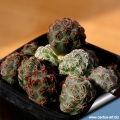
by Cactus Art

by Agócs György

by Valentino Vallicelli
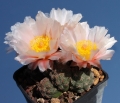
by Valentino Vallicelli
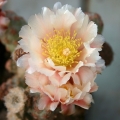
by Valentino Vallicelli
























